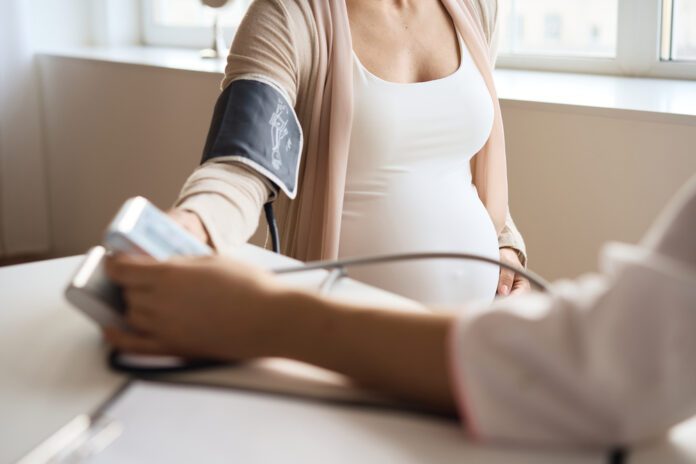Overview Of Preeclampsia
Preeclampsia is high blood pressure and signs of liver or kidney damage that occur in women after the 20th week of pregnancy. While rare, preeclampsia also may occur in a woman after delivering her baby, most often within 48 hours. This is called postpartum preeclampsia.
Commonly Associated With
Toxemia; Pregnancy-induced hypertension (PIH); Gestational hypertension; High blood pressure – preeclampsia
Causes
The exact cause of preeclampsia is unknown. It occurs in about 3% to 7% of all pregnancies. The condition is thought to start in the placenta.
Factors that may lead to preeclampsia developing include:
- Autoimmune disorders
- Blood vessel problems
- Your diet
- Your genes
Risk factors for the condition include:
- First pregnancy
- Past history of preeclampsia
- Multiple pregnancies (twins or more)
- Family history of preeclampsia
- Obesity
- Being older than age 35
- Being African American
- History of diabetes, high blood pressure, or kidney disease
- History of thyroid disease
Symptoms
Often, women who have preeclampsia do not feel sick.
Symptoms of preeclampsia can include:
- Swelling of the hands and face or eyes (edema)
- Sudden weight gain over 1 to 2 days or more than 2 pounds (0.9 kg) a week
- Note: Some swelling of the feet and ankles is considered normal during pregnancy.
Symptoms of severe preeclampsia include:
- Headache that does not go away or becomes worse.
- Trouble breathing.
- Belly pain on the right side, below the ribs. Pain may also be felt in the right shoulder and can be confused with heartburn, gallbladder pain, a stomach virus, or kicking by the baby.
- Not urinating very often.
- Nausea and vomiting (a worrisome sign).
- Vision changes, including temporary blindness, seeing flashing lights or spots, sensitivity to light, and blurry vision.
- Feeling lightheaded or faint.
Exams & Tests
The health care provider will do a physical exam. This may show:
- High blood pressure, often higher than 140/90 mm Hg
- Swelling in the hands and face
- Weight gain
Blood and urine tests will be done. This may show:
- Protein in the urine (proteinuria)
- Higher-than-normal liver enzymes
- Platelet count that is low
- Higher-than-normal creatinine levels in your blood
- Elevated uric acid levels
Tests will also be done to:
- See how well your blood clots
- Monitor the baby’s health
- The results of a pregnancy ultrasound, non-stress test, and other tests will help your provider decide whether your baby needs to be delivered right away.
Women who had low blood pressure at the start of their pregnancy, followed by a significant rise in blood pressure need to be watched closely for other signs of preeclampsia.
Treatment Of Preeclampsia
Preeclampsia often resolves after the baby is born and the placenta is delivered. However, it may persist or even begin after delivery.
Most often, at 37 weeks, your baby is developed enough to be healthy outside of the womb.
As a result, your provider will likely want your baby to be delivered so the preeclampsia does not get worse. You may get medicines to help trigger labor, or you may need a C-section.
If your baby is not fully developed and you have mild preeclampsia, the disease can often be managed at home until your baby has matured.
The provider will recommend:
- Frequent doctor visits to make sure you and your baby are doing well.
- Medicines to lower your blood pressure (sometimes).
- The severity of preeclampsia may change quickly, so you’ll need very careful follow-up.
- Complete bed rest is no longer recommended.
Sometimes, a pregnant woman with preeclampsia is admitted to the hospital. This allows the health care team to watch the baby and mother more closely.
Treatment in the hospital may include:
- Close monitoring of the mother and baby
- Medicines to control blood pressure and prevent seizures and other complications
- Steroid injections for pregnancies under 34 weeks gestation to help speed up the development of the baby’s lungs
You and your provider will continue to discuss the safest time to deliver your baby, considering:
- How close you are to your due date.
- The severity of the preeclampsia. Preeclampsia has many severe complications that can harm the mother.
- How well the baby is doing in the womb.
The baby must be delivered if there are signs of severe preeclampsia. These include:
- Tests that show your baby is not growing well or is not getting enough blood and oxygen.
- The bottom number of your blood pressure is over 110 mm Hg or is greater than 100 mm Hg consistently over a 24-hour period.
- Abnormal liver function test results.
- Severe headaches.
- Pain in the belly area (abdomen).
- Seizures or changes in mental function (eclampsia).
- Fluid buildup in the mother’s lungs.
- HELLP syndrome (rare).
- Low platelet count or bleeding.
- Low urine output, a lot of protein in the urine, and other signs that your kidneys are not working properly.



